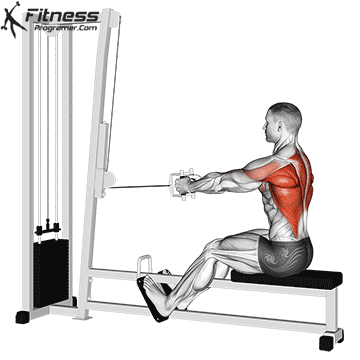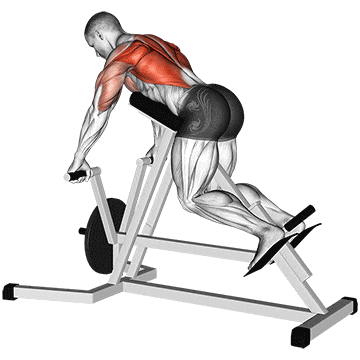DUMBBELL DENT OVER ROW

Dumbbell Bent-Over Row, which is a compound exercise targeting the back muscles, including the lats, rhomboids, and traps
- How to Perform Dumbbell Bent-Over Rows
SETUP
- Stand with your feet shoulder-width apart and hold a dumbbell in each hand, palms facing your torso (neutral grip).
- Hinge at your hips by bending forward while keeping your back straight and your knees slightly bent. Your torso should be almost parallel to the ground
STARTING POSITION
- Let the dumbbells hang at arm's length below you. Ensure your back is flat and your chest is up
EXECUTION
- Pull the dumbbells towards your lower rib cage, squeezing your shoulder blades together at the top of the movement.
- o Keep your elbows close to your body as you row the weights up. Focus on using your back muscles to lift the weights rather than your arms.
RETURNING TO POSITION
- Slowly lower the dumbbells back to the starting position in a controlled manner, fully extending your arms and maintaining tension in your back muscles.
- Avoid letting the weights drop quickly; control the descent to maximize muscle engagement
BREATHING
- Exhale as you row the dumbbells up and inhale as you lower them back down
DUMBBELL PULLOVER

The Dumbbell Pullover is an effective exercise that targets the muscles of the upper body, primarily focusing on the chest, back, and shoulders. It is a versatile movement that can help improve upper body strength and flexibility.
- How to Perform Dumbbell Pullovers
SETUP
- Lie on a flat bench with your upper back and shoulders supported. Your feet should be flat on the floor, and your knees should be bent
- Hold a single dumbbell with both hands, gripping it by one end. Extend your arms straight up above your chest
STARTING POSITION
- Keep your arms slightly bent at the elbows. Your hands should be positioned so that your palms are facing each other.
EXECUTION
- Lower the dumbbell slowly behind your head in an arc-like motion, maintaining a slight bend in your elbows. Feel a stretch in your chest and lats as you lower the weight.
- Pull the dumbbell back up to the starting position, focusing on using your chest and back muscles to lift the weight.
RETURNING TO POSITION
- Bring the dumbbell back to the starting position above your chest, maintaining control throughout the movement
- Ensure that you do not use momentum or let the weight drop too quickly
BREATHING
- Inhale as you lower the dumbbell behind your head, and exhale as you pull the dumbbell back up to the starting position
LAT PULL DOWN BACK

Lat Pulldowns are a popular exercise for targeting the latissimus dorsi muscles in the back. They also engage the biceps, shoulders, and core. This exercise is often performed on a cable machine with a wide grip bar, making it a great alternative to pull-ups for building back strength.
- How to Perform Lat Pulldowns
SETUP
- Sit at a lat pulldown machine with your feet flat on the floor and your knees secured under the pad
- Reach up and grasp the bar with a wide grip (palms facing away from you) or a different grip as per your workout goal. Your hands should be slightly wider than shoulder-width apart
STARTING POSITION
- Sit up straight with your back slightly arched and your chest up. Your arms should be fully extended, and the bar should be positioned above your head.
EXECUTION
- Pull the bar down towards your upper chest, leading with your elbows and squeezing your shoulder blades together as you lower the bar
- Focus on engaging your back muscles (lats) to perform the movement rather than just using your arms.
- Keep your torso stable and avoid leaning back excessively or using momentum
RETURNING TO POSITION
- Slowly extend your arms back to the starting position, allowing the bar to rise back up while maintaining tension in your lats.
- Control the ascent to avoid letting the weight drop too quickly.
BREATHING
- Exhale as you pull the bar down towards your chest, and inhale as you return to the starting position
PULL UPS

Pull-ups are a fundamental bodyweight exercise that primarily targets the latissimus dorsi muscles in the back, but also engages the biceps, shoulders, and core. They are known for their effectiveness in building upper body strength and muscle definition.
- How to Perform Pull-Ups
SETUP
- Find a sturdy pull-up bar that is high enough for you to hang from with your arms fully extended without touching the ground.
- Grip the bar with your hands slightly wider than shoulder-width apart. You can use an overhand grip (palms facing away from you) for traditional pull-ups or an underhand grip (palms facing you) for chin-ups
STARTING POSITION
- Hang from the bar with your arms fully extended and your body in a straight line. Your legs can be slightly bent or crossed behind you to help stabilize your body.
EXECUTION
- Engage your core and pull your body upwards by bending your elbows and driving your chest towards the bar.
- Focus on using your back muscles and biceps to lift your body. Keep your shoulders down and away from your ears, and avoid swinging or using momentum
RETURNING TO POSITION
- Slowly lower your body back to the starting position, fully extending your arms while maintaining control. Ensure that the descent is controlled to maximize muscle engagement
BREATHING
- Exhale as you pull yourself up and inhale as you lower yourself back down
SEATED ROW

Seated Rows are a popular exercise for targeting the muscles of the back, including the lats, rhomboids, and traps. This exercise also engages the biceps and forearms. Seated rows can be performed using various types of equipment, including cable machines, rowing machines, or resistance bands.
- How to Perform Seated Rows
SETUP
- Sit on a rowing machine or cable machine with a seated row attachment. Your feet should be flat on the platform or floor, and your knees should be slightly bent.
- Grip the handles or bar with your hands. Your grip can vary (wide, narrow, neutral) depending on the attachment and the muscle emphasis desired
STARTING POSITION
- Sit up straight with your back slightly arched and your chest up. Extend your arms forward, keeping your shoulders down and relaxed.
EXECUTION
- Pull the handles or bar towards your torso by bending your elbows and squeezing your shoulder blades together. Focus on using your back muscles to pull the weight
- Keep your elbows close to your body and avoid leaning back or using excessive momentum
RETURNING TO POSITION
- Slowly extend your arms back to the starting position, allowing the weight to return to the starting position while maintaining control
- Ensure that your torso remains stable and avoid letting the weight drop too quickly.
BREATHING
- Exhale as you pull the handles towards your torso, and inhale as you return to the starting position
T-BAR RUDERN

T-Bar Rudern (or T-Bar Row in English) is a powerful exercise used to develop the upper and middle back, particularly targeting the latissimus dorsi, rhomboids, and trapezius muscles. This exercise can also engage the biceps, forearms, and rear deltoids
- How to Perform T-Bar Rudern
SETUP
- Load your desired weight onto one end of a T-Bar Row machine or a barbell.
- If using a barbell, place the bar in a corner or use a T-Bar Row attachment to secure it
- Stand over the bar with your feet shoulder-width apart. Slightly bend your knees and hinge at your hips, keeping your back flat and chest up.
STARTING POSITION
- Grip the handles of the T-Bar Row machine or the barbell with both hands. Your hands should be slightly wider than shoulder-width apart.
- Maintain a slight bend in your knees and keep your torso nearly parallel to the floor.
EXECUTION
- Pull the bar towards your chest or upper abdomen by bending your elbows and squeezing your shoulder blades together.
- Focus on using your back muscles to perform the movement. Keep your elbows close to your body and avoid using excessive momentum.
RETURNING TO POSITION
- Slowly lower the bar back to the starting position, fully extending your arms while maintaining control. Avoid letting the weight drop too quickly
BREATHING
- Exhale as you pull the weight towards your torso and inhale as you lower it back to the starting position.